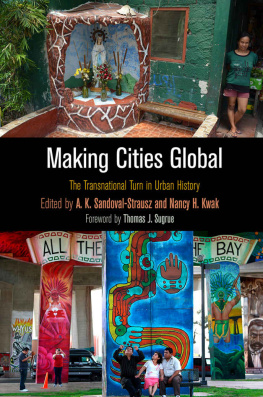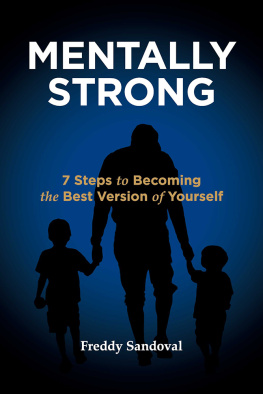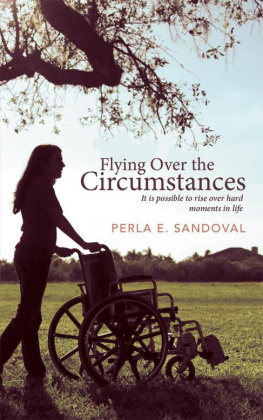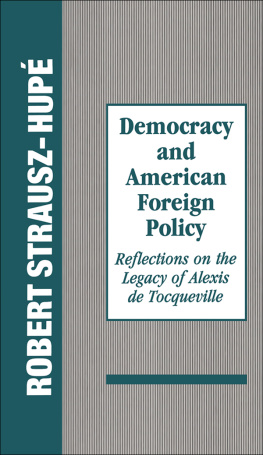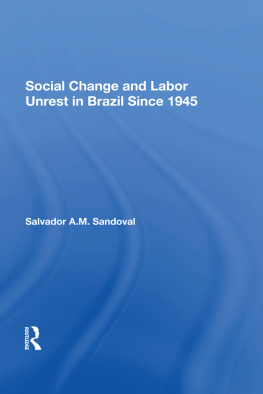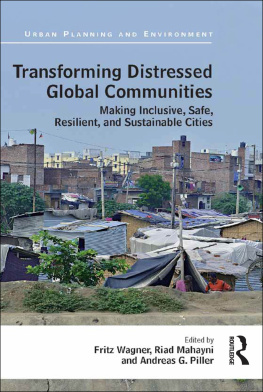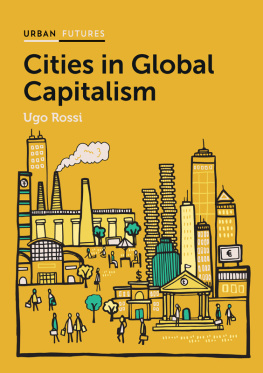A. K. Sandoval-Strausz - Making Cities Global
Here you can read online A. K. Sandoval-Strausz - Making Cities Global full text of the book (entire story) in english for free. Download pdf and epub, get meaning, cover and reviews about this ebook. year: 2017, publisher: University of Pennsylvania Press, Inc., genre: Politics. Description of the work, (preface) as well as reviews are available. Best literature library LitArk.com created for fans of good reading and offers a wide selection of genres:
Romance novel
Science fiction
Adventure
Detective
Science
History
Home and family
Prose
Art
Politics
Computer
Non-fiction
Religion
Business
Children
Humor
Choose a favorite category and find really read worthwhile books. Enjoy immersion in the world of imagination, feel the emotions of the characters or learn something new for yourself, make an fascinating discovery.
- Book:Making Cities Global
- Author:
- Publisher:University of Pennsylvania Press, Inc.
- Genre:
- Year:2017
- Rating:3 / 5
- Favourites:Add to favourites
- Your mark:
- 60
- 1
- 2
- 3
- 4
- 5
Making Cities Global: summary, description and annotation
We offer to read an annotation, description, summary or preface (depends on what the author of the book "Making Cities Global" wrote himself). If you haven't found the necessary information about the book — write in the comments, we will try to find it.
Making Cities Global — read online for free the complete book (whole text) full work
Below is the text of the book, divided by pages. System saving the place of the last page read, allows you to conveniently read the book "Making Cities Global" online for free, without having to search again every time where you left off. Put a bookmark, and you can go to the page where you finished reading at any time.
Font size:
Interval:
Bookmark:
MAKING CITIES GLOBAL
MAKING CITIES GLOBAL
THE TRANSNATIONAL TURN IN URBAN HISTORY
EDITED BY
A. K. SANDOVAL-STRAUSZ AND NANCY H. KWAK

UNIVERSITY OF PENNSYLVANIA PRESS
PHILADELPHIA
This volume was published with the support of the Princeton UniversityAndrew W. Mellon Foundation Initiative in Architecture, Urbanism, and the Humanities and the University of CaliforniaSan Diego.
Copyright 2018 University of Pennsylvania Press
All rights reserved. Except for brief quotations used for purposes of review or scholarly citation, none of this book may be reproduced in any form by any means without written permission from the publisher.
Published by
University of Pennsylvania Press
Philadelphia, Pennsylvania 19104-4112
www.upenn.edu/pennpress
Printed in the United States of America on acid-free paper
10 9 8 7 6 5 4 3 2 1
Library of Congress Cataloging-in-Publication Data
Names: Sandoval-Strausz, A. K., editor. | Kwak, Nancy, 1973 editor.
Title: Making cities global : the transnational turn in urban history / edited by A. K. Sandoval-Strausz and Nancy H. Kwak.
Description: 1st edition. | Philadelphia : University of Pennsylvania Press, [2018] | Includes bibliographical references and index.
Identifiers: LCCN 2017012497 | ISBN 9780812249545 (hardcover : alk. paper)
Subjects: LCSH: TransnationalismHistory20th centuryCase studies. | UrbanizationAmericaHistory20th centuryCase studies. | UrbanizationIndiaHistory20th centuryCase studies. | Cities and townsAmericaHistory20th centuryCase studies. | Cities and townsIndiaHistory20th centuryCase studies. | GlobalizationPolitical aspectsCase studies.
Classification: LCC JZ1320 .M35 2017 | DDC 303.48/270091732dc23
LC record available at https://lccn.loc.gov/2017012497
CONTENTS

Thomas J. Sugrue
A. K. Sandoval-Strausz and Nancy H. Kwak
Margaret OMara
Amy C. Offner
Leandro Benmergui
Nancy H. Kwak
Carola Hein
Erica Allen-Kim
Matt Garcia
Arijit Sen
Richard Harris
Nikhil Rao
Carl H. Nightingale
FOREWORD

THOMAS J. SUGRUE
It has been nearly two decades since the Organization of American Historians released its La Pietra Report, an influential call for the creation of a transnational or global approach to the nations history. The report, drafted by distinguished intellectual and urban historian Thomas Bender in consultation with nearly one hundred major scholars, offered this exhortation: The lived and experienced connections in transnational space need to be exploredboth the channels that facilitate movement and the ruptures, discontinuities, and disarticulations that structure inequalities and constitute the basis for national and other forms of differentiation. Coming after years of scholarship dominated by place-based case studies in social and cultural history, La Pietra issued a radical historiographical challenge, calling on Americanists to rethink the scales, temporalities, and networks of historical transformation.
La Pietra marked a watershed in the field. In recent years, major history departments have conducted searches for faculty specializing in the United States and the world. Graduate programs regularly offer transnational or global history tracks, reflecting a reorientation of the profession. Intellectual historians, following Daniel Rodgers, traced Atlantic crossings of ideas of social reform. Scholars of region, immigration, and ethnicity, fields that enjoyed a revival in the early twenty-first century, turned their attention to borderlands and diasporas, rejecting old notions of assimilation and Americanization. Questions of imperialism, colonization, and decolonization moved to the cutting edge of cultural studies. But, with a handful of noteworthy exceptions, urban historians came late to the transnational wave.
Urban history as a field has long been concerned with scales, temporalities, and networks, three keywords in the La Pietra Report. But for the majority of American urbanists, the scale was intensely local. For good reasons, They made it impossible to think about urbanism simply at the local level.
But despite calls for a transnational turn, only a handful of urbanists stepped outside the boundaries of the nation-state altogether to lay the groundwork for a new, expansive global urban history. Pioneers like Sven Beckert considered the networks of capital and commodities that connected cities as diverse as Liverpool, Mumbai, and New Orleans; Christopher Klemek followed the flow of ideas about urban renewal and city planning that traveled from Paris to New York, from Berlin to Toronto to Boston; and Carl Nightingale traced the segregation mania that linked the histories of places as far-flung as New Delhi, Cape Town, and Baltimore.
The authors in this volume represent cutting-edge work in urban history throughout the Americas and across the Pacific. Some, like Nightingale (who was part of the La Pietra working group) have been involved in transnational, multiarchival, multilingual research for decades. Others, like its coeditors, have just recently published field-defining books and articles that explode the scales and temporalities that have long shaped urban historiography.local politics. But each also opens up new avenues for interrogating the local, whether tracing economic planning in Colombia and the Philippines or showing how immigrants and ideas reshaped American and Asian cities and suburbs, their storefronts and sidewalks and dwellings, into something that reflected the architecture and aesthetics of their places of origin. The authors offer a powerful reminder that cities are often shaped by economic decisions made thousands of miles away, through networks that transcend single places, by people whose identities and politics defy simple categorization. The result is an extraordinary collection of essays, one that brings the promise of La Pietra to fruition and sets a new direction for the next generation of American historians who think, research, and write globally and locally and at every scale in between.
Introduction
Why Transnationalize Urban History?
A. K. SANDOVAL-STRAUSZ AND NANCY H. KWAK
Cities today are growing faster and in more places than ever before, and the future looks to be unprecedentedly urban. In 1900, only about 13 percent of the worlds population lived in cities; in 1950, that proportion had grown to 30 percent. The number of people in urban areas reached parity with the number in rural areas in 2007, and the most recent figures suggest that humanity is now 54 percent urbanized. The regions that are most urban at present are Northern America, Latin America and the Caribbean, and Europe, but the fastest rates of urbanization are now seen in Asia and Africa, which together account for more than half of the planets urban population. Current estimates indicate that by 2050, two-thirds of the global population will be city dwellers.
This process of urbanization has critical transnational dimensions. Human migration has accelerated over recent decades, and as individuals and groups relocate from rural areas to cities, many of them cross national boundaries. According to the latest estimates, the number of people on the move has increased by nearly 60 percent since 1990, and the worlds migrant population is now approximately a quarter billion people. Cities are also shaped by the flow of investments and other forms of money, which move with unprecedented speed and volume, changing markets for food, services, and especially housingand in the process generating greater inequalities from person to person and place to place. Environmental effects, meanwhile, are indifferent to national borders. Human activity is altering climates and impacting ecosystems around the world, in turn potentially setting off further movements of people and capital and leaving some populations more vulnerable than others.
Next pageFont size:
Interval:
Bookmark:
Similar books «Making Cities Global»
Look at similar books to Making Cities Global. We have selected literature similar in name and meaning in the hope of providing readers with more options to find new, interesting, not yet read works.
Discussion, reviews of the book Making Cities Global and just readers' own opinions. Leave your comments, write what you think about the work, its meaning or the main characters. Specify what exactly you liked and what you didn't like, and why you think so.

